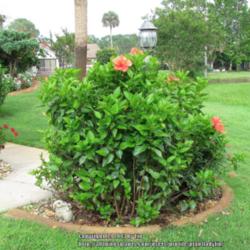| I have what looks like small black ants on my hibiscus they seem to be eating the bud. What can I spray on them? |

The way that ants do harm hibiscus is by carrying aphid eggs onto the plants. Aphids are unsightly for sure, but even worse is their ability to serve as a vector for plant viruses. The ants don't care, they are after the honeydew that aphids make from the plant sap that they ingest. So they carefully "farm" and herd the aphids like "cows" to milk them for their honeydew. Ants ferociously guard their "cows", fighting off other insect predators, like ladybugs, that could help keep the aphid numbers in check. Another side effect of ants and their aphids is the organism, black sooty mold, which is also fond of aphid honeydew. When spores of the mold land on the honeydew, they quickly spread to cover it and the hibiscus leaf. This black mold feeds on the honeydew, not on the hibiscus leaf, and does not directly harm the plant. However, black mold looks terrible and can block the sunlight that the leaves need in order for the all important photosynthesis to take place inside the plant leaf. A good least-toxic method is the use of boric acid baits. Boric acid baits can eliminate some ant colonies in about one week. The trick is to not kill the ants at the bait station, but to get the ants to carry the boric acid back to the nest, poisoning the members of the colony that never leave the nest. Most ants feed either on sugars or on protein, fats, or oils. To see which type you have, place small dabs of jelly and peanut butter (not mixed) where ants are seen and watch which food they are attracted to. If they are attracted to the jelly, you can make a boric acid bait by mixing one-half cup jelly, such as apple jelly, with 1 1/4 tsp boric acid powder. Punch several holes in the lid of the jar, then screw the lid on tightly and seal with tape. The holes should be large enough for the ants to pass through to reach the bait. Place the bait jar on its side where the ants will come in contact with it. If the ants are unable to gain footing on the jar lid, you might want to scratch the surface with sandpaper or a pebble. If the ants are attracted to peanut butter, use that for your bait rather than jelly. If you find many dead ants around the bait station, which ever bait you use, lower the amount of boric acid in the mixture. If you are still finding live ants after a week to 10 days, increase the amount of boric acid. Although boric acid is of very low toxicity, it is best to place bait jars where children and pets cannot reach them. Best wishes with your hibiscus. |